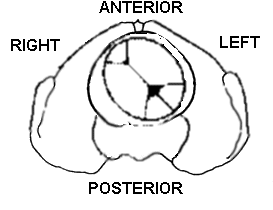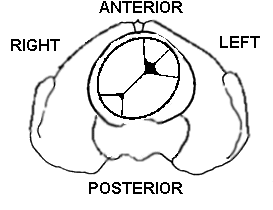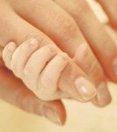Red blood cell distribution width % (RDW)
The variability of red blood cell size (anisocytosis). RDW (%) = {SD of red blood cell volume (fL) / MCV (fL)} × 100.
Reproductive endocrinologist
A physician who has completed specialty training in obstetrics and gynecology and additional subspecialty training in the treatment of infertility, recurrent miscarriages, and hormonal disorders in women.
Respiratory distress syndrome (RDS, hyaline membrane disease, HMD)
A condition of the lungs where the lungs are too stiff to expand because a substance (surfactant) is not present to prevent the tiny air sacs in the lungs (alveoli) from collapsing and sticking together. Damaged cells collect in the airways and form a glassy (hyaline) membrane over the alveoli. RDS is most likely to occur in premature infants less than 32 weeks' gestational age, and is twice as common in boys.
Signs of RDS include grunting with expiration, rapid breathing (tachypnea), use of the muscles between and below the ribs to aid breathing (intercostal and subcostal retractions), enlargement of the nostrils during breathing (nasal flaring), and bluish discoloration of the skin due to lack of oxygen (cyanosis). These signs are nearly always present before 8 hours of age, and can be expected to subside after the third day.
Rett syndrome
A neurodevelopmental disorder that is classified as an autism spectrum disorder by the DSM-IV. The disorder was described by Dr. Andreas Rett, an Austrian physician, in 1966.
Children with Rett syndrome develop normally for six to eighteen months, but then they start to regress, losing language skills and physical coordination. The children lose the ability to make purposeful movements and many habitually wring their hands.
Rett syndrome affects one in every 10,000 to 15,000 live female births and is caused by mutations in the MECP2 (methyl CpG binding protein 2) gene located on the X chromosome. It occurs in all racial and ethnic groups worldwide. Prenatal testing is available for families with an affected daughter who has an identified MECP2 mutation. Since the disorder occurs spontaneously in most affected individuals, however, the risk of a family having a second child with the disorder is less than 1 percent.
Genetic testing is also available for sisters of girls with Rett syndrome and an identified MECP2 mutation to determine if they are asymptomatic carriers of the disorder, which is an extremely rare possibility.
Boys who have an MECP2 mutation known to cause Rett syndrome in girls die shortly after birth. Males that survive with Rett syndrome most likely also have Klinefelter's syndrome (in which the male has an XXY karyotype). Other types of mutations in the MECP2 gene can cause mental retardation in boys.
1. National Institute of Neurological Disorders and Stroke
2. Schwartzman JS, et al. Rett Syndrome in a Boy with 47,XXY Karyotype Confirmed by a Rare
Mutation on the MECP2 Gene. Neuropediatrics. 2001;32:162–164.
ROA (Right occiput anterior)
Describes the position of the fetal occiput (back of the head) as being to the right side of the maternal birth canal (position) and anterior in relation to the mother's pelvis (variety).

ROP (Right occiput posterior)
Describes the position of the fetal occiput (back of the head) as being to the right side of the maternal birth canal (position) and posterior in relation to the mother's pelvis (variety).

Round ligaments
The round ligaments of the uterus are two flattened bands extending from each side of the uterus that proceed forward through a tunnel in the abdominal wall (the inguinal canal) to the large folds of skin at the opening of the vagina (labium majus). The ligaments help to stabilize the uterus and are composed of muscular tissue with some fibrous tissue, blood vessels, lymphatics, and nerves enclosed by the lining of the abdominal cavity (peritoneum).
Round ligament pain
Sharp pain in the lower abdomen or groin caused by spasm of the round ligaments of the uterus. The pains usually last a few seconds and are associated with rapid movement or rolling over during sleep.
Rubella (German measles)
A viral illness caused by a togavirus. The virus is spread from human to human through respiratory and throat secretions. The illness has an incubation period of 2 to 3 weeks. Adults may experience low grade fever, headache, inflammation of the lining of the eyes (conjunctivitis), profuse nasal discharge, and joint pains. One half of patients may experience a fine pink flat macular rash on the face that spreads to the trunk and limbs. Enlargement of the lymph nodes behind the ears, neck, and head is common.
Infection during pregnancy, especially during the first trimester, often causes congenital rubella syndrome (CRS), resulting in miscarriage, stillbirth, growth restriction, fetal liver and spleen enlargement, and birth defects including microcephaly, cataracts, heart defects, blindness, sensorineural deafness, and mental retardation.
Fortunately rubella has become rare in the United States due to widespread immunization against rubella. Nine cases of rubella were reported in 2004, and four cases of CRS were reported during 2001–2004 [1]. However, CRS continues to occur in large numbers outside of the United States.
Rupture of membranes (ROM, “breaking of the water bag”)
Breaking or tearing open of the fluid-filled amniotic sac. Often described as a “gush of fluid.”
